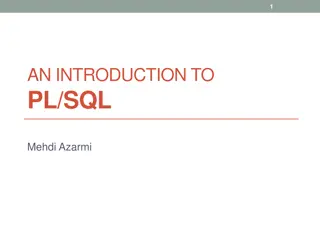Python-Based Model for SQL Injection and Web Application Security
The research focuses on combating SQL injection attacks in web applications using a Python-based neural network model. By training the model on a dataset and conducting blind testing, it achieved up to 81% accuracy in detecting malicious network traffic. This innovative approach aims to enhance cybersecurity in the face of evolving threats like SQLIA.
Download Presentation

Please find below an Image/Link to download the presentation.
The content on the website is provided AS IS for your information and personal use only. It may not be sold, licensed, or shared on other websites without obtaining consent from the author. Download presentation by click this link. If you encounter any issues during the download, it is possible that the publisher has removed the file from their server.
E N D
Presentation Transcript
SQL INJECTION & WEB APPLICATION SECURITY: A Python-Based Network Traffic Detection Model
ABSTRACT The Internet of Things (IoT) presents a great many challenges in cybersecurity as the world grows more and more digitally dependent. Personally identifiable information (PII) (i,e,. names, addresses, emails, credit card numbers) is stored in databases across websites the world over. The greatest threat to privacy, according to the Open Worldwide Application Security Project (OWASP) is SQL injection attacks (SQLIA) [1]. In these sorts of attacks, hackers use malicious statements entered into forms, search bars, and other browser input mediums to trick the web application server into divulging database assets. A proposed against such exploitation is convolution neural network modeling. We have written a proof of concept, Python-based program that takes advantage of the PyTorch package s built-in convolution layered modeling classes. The model has been trained on a dataset of four known classifications and after reaching maturity underwent blind validation on a separate dataset 1000 times. The model was able to reach up to 81% accuracy by correctly reporting the packet classification. We believe the same behavior can be mapped to malicious SQLIA in other datasets by marking features in web traffic with abnormally large packet sizes, network errors, and unrecognized server responses. The research presented herein serves to corroborate related research in the field employing similar neural network and deep learning techniques to today s greatest threat to cybersecurity.
OUTLINE Background Dataset & Methods Hyperparameters & Training Blind Testing Implications
BACKGROUND Web Application Vulnerability Database Security & SQL SQL Injection Attacks (SQLIA)
EXAMPLE: COMMENT INJECTION [1] SELECT * FROM users WHERE username = $USERNAME AND password = $PASSWORD; [2] 1 or 1=1; # [3] SELECT * FROM users WHERE username = 1 n include() which accepts a PHP file and enables the server to run the code in that file. or 1=1; # AND password = $PASSWORD;
DATASET & METHODS Flow Sequence Network (FS-Net) Neural Network Machine Learning PyTorch Library Sequence Regression Gradient Descent
HYPERPARAMETERS & TRAINING [1] batch_size = 260 [2] learning_rate = 0.001 [3] num_epochs = 80 [4] drop_rate = 0.001
HYPERPARAMETERS & TRAINING Figure 1: Loss Penalty for Training Model Figure 2: Accuracy for Training Model
BLIND TESTING 81% Average Accuracy on 1000 Tests Figure 3: Boxplot of Accuracy after Validation
CONCLUSIONS & IMPLICATIONS Proof of concept SQLIA can be marked by: Abnormally large packets Network errors Unrecognized server responses Requires further research


























